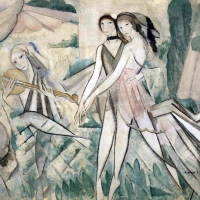 April
08
April
08
Tags
Classicism to Surrealism: Dali’s Venus with Drawers
 On the 8th of April 1820, the statue of Venus de Milo was discovered by a peasant called Yorgos Kentrotas within a buried niche in the ancient city ruins of Milos (currently Tripiti) in the Aegean. Between 130 and 100 BC when the work was created, Milos was still part of the Ottoman Empire. Perhaps the best known and loved ancient Greek sculpture, it appears to depict Aphrodite, the Greek goddess of love and beauty (Venus to the Romans). The over-life size armless marble is attributed to Alexandros of Antioch and is on permanent display at the Louvre.
On the 8th of April 1820, the statue of Venus de Milo was discovered by a peasant called Yorgos Kentrotas within a buried niche in the ancient city ruins of Milos (currently Tripiti) in the Aegean. Between 130 and 100 BC when the work was created, Milos was still part of the Ottoman Empire. Perhaps the best known and loved ancient Greek sculpture, it appears to depict Aphrodite, the Greek goddess of love and beauty (Venus to the Romans). The over-life size armless marble is attributed to Alexandros of Antioch and is on permanent display at the Louvre.
Fast-forward to 1936, and an entirely different Venus is born in the studio of Europe’s most eccentric modern artist, Salvador Dali. His “Venus de Milo with Drawers, a half-size plaster reproduction of the famous marble, altered with pompon-decorated drawers in the figure’s forehead, breasts, stomach, abdomen, and left knee. The provoking combination of cool painted plaster and silky mink tufts illustrates the Surrealist interest in uniting different elements to spark a new reality. For the Surrealists, the best means of provoking this revolution of consciousness was a special kind of sculpture that, as Dali explained in a 1931 essay, was “absolutely useless … and created wholly for the purpose of materializing in a fetishistic way, with maximum tangible reality, ideas and fantasies of a delirious character.” Dali’s article, which drew upon the ideas of Marcel Duchamp’s ‘readymades’, inaugurated object making as an integral part of Surrealist activity.” (Stephanie D’Alessandro, ‘Chicago Venus de Milo with Drawers’, Art Institute of Chicago Museum Studies, Vol. 32, No. 1, Notable Acquisitions at The Art Institute of Chicago, 2006).
 As it happens, Dali’s first sculpture as a child was a clay study of the Venus de Milo and he had been mesmerised by her presence ever since. “My first experience as a sculptor gave me an unknown and delicious erotic joy”, he recalled. The quintessential symbol of classical female beauty, the goddess reappeared throughout his career. She was the focus of his 1939 Dream of Venus Pavilion at the World’s Fair, where the viewer is invited to walk through her dreams; then in The Hallucinogenic Toreador of 1969, shadows across her body become the source for an illusion of a bullfighter’s face and in a 1973 hologram, she appears as musician Alice Cooper’s microphone.
As it happens, Dali’s first sculpture as a child was a clay study of the Venus de Milo and he had been mesmerised by her presence ever since. “My first experience as a sculptor gave me an unknown and delicious erotic joy”, he recalled. The quintessential symbol of classical female beauty, the goddess reappeared throughout his career. She was the focus of his 1939 Dream of Venus Pavilion at the World’s Fair, where the viewer is invited to walk through her dreams; then in The Hallucinogenic Toreador of 1969, shadows across her body become the source for an illusion of a bullfighter’s face and in a 1973 hologram, she appears as musician Alice Cooper’s microphone.
For this 1936 Surrealist object, Dali cut six drawers into Venus, transforming the Greek statue into a piece of living furniture, an appropriated object he called an “anthropomorphic cabinet”, reminiscent of later Duchampian visual puns – here, a play on the phrase “chest” of drawers”. Legend goes that the young Dali had a friend from a worker’s family, who always wore clothes with several sewn pockets on, hence his later penchant for compartmentalisation in pockets and drawers. Dali’s Venus has a simple, white surface, complemented by elegant fur knobs, a reference to her beauty and erotic appeal.
The artist intended the drawers as a metaphor for the way Freudian psychoanalysis opens the hidden areas of the unconscious. Dali’s Venus is a three-dimensional culmination of his explorations into the deep, psychological mysteries of sexual desire. In Dali’s words, “Freud discovered the world of the subconscious on the tumid surfaces of ancient bodies, and Dali cut drawers into it.” Dali was deeply influenced by the work of Freud, claiming that “The only difference between immortal Greece and contemporary times is Sigmund Freud, who discovered that the human body, purely platonic in the Greek epoch, is nowadays full of secret drawers that only psychoanalysis is capable to open.” In Freud’s Delusion and Dream in Jensen’s Gradiva, a 1907 essay, the psychoanalyst dissects Wilhelm Jensen and his novel Gradiva. Its story follows the young archaeologist Norbert Hanold, who, in a dream, sees the girl featured in the ancient Gradiva bas-relief walking in the streets of Pompeii while the hot ashes of Vesuvius subsume the city in 79 AD. However, as he approaches her, the girl answers him in German. This is interpreted as a long and gradual realisation of Harold’s love for his childhood friend through the association with the idealized woman from a neo-Attic Roman bas-relief. Freud considered the novel as providing a prime example of “something which might be called ‘cure by seduction’ or ‘cure by love’, as well as evidence “that the Oedipus complex is still active in normal adults, too”. (Delusion and Dream in Jensen’s Gradiva)
 Dali’s love for Freudian psychoanalysis reached an all-time high when he met Freud in person. The latter allegedly said,“In classic paintings I look for the subconscious – in a surrealist painting for the conscious.” With the clear implication that the painter’s work was over-intellectualised, Freud’s remark to Dali when they met in London in 1938 was interpreted by the artist as “a death sentence on surrealism”. I tend to view Freud’s comment as a joke, and an extremely good one. Nearing the end of his life (he died in September 1939), Freud was a refugee from Nazi-occupied Austria, where he was condemned for exalting human instincts. Of course the opposite was true. Freud insisted that instinct had to be repressed for the sake of civilized life. It was barbarians such as the Nazis, and decadents such as Dali, who made a cult of instinct, whereas Freud – the explorer of the unconscious – always held to an idea of reason. (John Gray, The Guardian, Friday 30 March 2012)
Dali’s love for Freudian psychoanalysis reached an all-time high when he met Freud in person. The latter allegedly said,“In classic paintings I look for the subconscious – in a surrealist painting for the conscious.” With the clear implication that the painter’s work was over-intellectualised, Freud’s remark to Dali when they met in London in 1938 was interpreted by the artist as “a death sentence on surrealism”. I tend to view Freud’s comment as a joke, and an extremely good one. Nearing the end of his life (he died in September 1939), Freud was a refugee from Nazi-occupied Austria, where he was condemned for exalting human instincts. Of course the opposite was true. Freud insisted that instinct had to be repressed for the sake of civilized life. It was barbarians such as the Nazis, and decadents such as Dali, who made a cult of instinct, whereas Freud – the explorer of the unconscious – always held to an idea of reason. (John Gray, The Guardian, Friday 30 March 2012)










Reblogged this on Manolis.
LikeLike